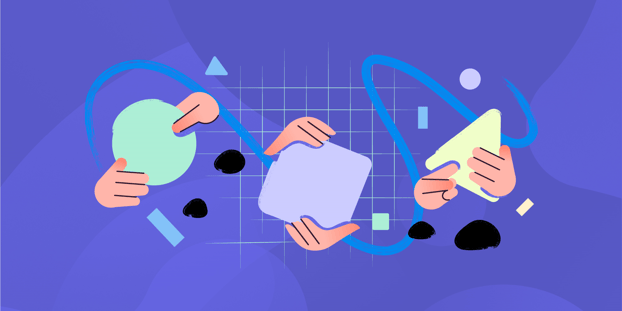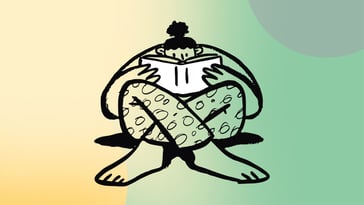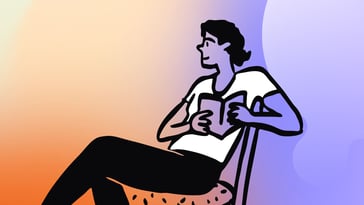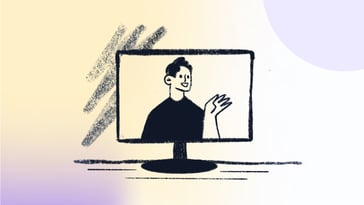If you’ve ever found yourself returning to an application or online service because it just “feels right” or seems to mimic your needs without you having to give active feedback, then you’ve most likely encountered a business that has good design experience (XD) behind it.
Among the many elements in experience management, experience design is arguably the most impactful. As we venture into a new ITSM landscape, we can see that the paradigm of the service economy has been slowly but steadily shifting to an experience-based economy. That is, customers, employees, and stakeholders are nowadays prioritizing how an experience feels.
That’s not to say that the service is not essential, but it is considered a given. The tools for creating services are more democratized than in the past. Therefore, companies that truly stand out are those who can make their particular service one that feels intuitive, natural, and familiar to the user.
In this article, we’ll learn what experience design is, how and why it’s essential, the difference between experience design and design thinking, and how businesses use experience design to leave a lasting footprint in the current market.
Follow us as we dive deeper into the infinitely creative world of experience design, and learn more about how to create products and services that elicit emotion as well as fulfilling customers’ needs.
What is experience design?
Just as its name implies, experience design is a business approach that centers on people’s experiences and uses them as the driving force behind the design of a product or service’s features, strategies, processes, and environments. Experience design takes inspiration from a user’s emotions, needs, feelings, and contexts to deliver a more impactful and memorable human-centered product or service.
Experience design is, by definition, human-centered design.
When we talk about this, we contemplate every single aspect that stems from creating a product or service way beyond the product or service itself. While experience design could be easily confused with user experience (UX) design, the latter is concerned with just the experience from the user’s side.
Successful experience design is deeply ingrained in every step that a business takes internally and externally, while user experience design looks at experiences exclusively from the customer’s perspective. It is less holistic than experience design.
For instance, these experiences could be anything from a friendly and intelligent clothing store chatbot that seems to know customers (because its answers match the kinds of questions users have made in the past) to a company’s internal, cultural, and organizational experiential change that better articulates the roles of the marketing department and shipping departments to make sure product orders arrive quicker.
Lastly, and perhaps more importantly, experience design can be the keystone of a company’s core business strategy. Loads of companies such as Uber and Airbnb have made their mark on the market thanks to their laser-focused approach to experience design and customer interaction when developing and growing their businesses.
Why is experience design important?
Experience design is important because rather than just focusing on making customer experience “better” or making a user’s life “easier,” the scope is much broader and all-encompassing than just finding a solution to an issue. The key goal is to shape customers' feelings when interacting with a service, a digital or non-digital product, and even the company. To better illustrate this idea, let’s look at an example.
A company might think having flashy and expressive graphic popups in their app might make the difference in delivering a good experience. However, how good is it if the button they are looking for is hidden behind all the bells and whistles?
In truth, all companies deliver an experience, whether they know it or not. Suppose a company can use its tools and touch points with customers as leverage to elicit positive emotions. In that case, that company’s experience design could be deemed as positive. At the same time, companies who don’t factor in these variables are prone to coming across as out of touch with a customer’s real needs and patterns of consumption/use.
Every single interaction should be well considered. Consequently, one could say that an interaction design is also part of the overall experience design.
The bottom line is that when delving into experience design, companies no longer focus exclusively on product design and quality. Still, on the experience, a meaningful experience becomes a more significant selling point than the product or service itself, and thus, it boosts the product or service’s appeal.
The 5 principles of experience design
When it comes to the essentials of design experience, one could break down its main principles into 5 key stages, each detailing aspects that make up the core idea behind the creation of well-designed experiences. We’ll look at these principles of experience design from an instructional design perspective, so they can be followed by anyone looking to start an experience design project.
1. Empathize
This is a great life skill, of course, but from a business standpoint, it is the engine behind significant and innovative changes. Empathy is the key to understanding the beliefs, emotions, and worldviews that drive users’ decisions. One needs to look no further than the critical factor that fueled the idea behind Uber. Their creators were having trouble getting a taxi in Paris.
After empathizing with people who might have been in the same situation, the core concept behind Uber came into existence. In simple terms, putting yourself in other people’s shoes helps you visualize what’s at the center of their needs and preferences, and being a good learner of said needs and preferences makes all the difference.
2. Define
This is where companies start narrowing down exactly what types of needs and problems their target audience has. Many businesses rely on design as a service to access expertise and tools that help them define these needs effectively.
It is the time to take data-driven decisions and a robust knowledge of information science is a must. A product or service must be surveyed qualitatively and quantitatively, so making an informed decision saves time and effort.
If a company starts making changes based on hunches and assumptions, it would be like throwing darts at a board while blindfolded, they might hit the mark, but it would be hazardous. Using surveying tools and carrying out surveys during and after a user has interacted with a product or service can go a long way when it comes to solving customer issues and even aid companies in avoiding them altogether! User research is a must.
3. Ideate
The most creative part of the whole process, originality, isn’t really on making things work but instead on coming up with ideas that might work, taking into account all the gathered data during the survey stage. Companies should be looking to challenge and put previously successful ideas to the test and use creative thinking to propose new and innovative solutions.
All the spitballing and brainstorming happens at this stage of the experience design process, and frequently UX designers, stakeholders, and managers are encouraged to pitch in and give their two cents.
4. Prototype
Companies should start implementing the previously ideated concepts in a controlled environment. These implementations could be a bit rough around the ages, and they might be relatively inexpensive compared to the final product or feature.
For instance, the user interface's visual design might not be fully realized. The idea is to see if the ship could sail with the ideas bouncing around the design room. Tweaking and adjusting might be needed, but to get there, prototypes are the critical feature companies should always have in their experience design arsenal.
5. Test
It’s time to take the ship out into deep waters. It could be a small-scale test by providing beta-testers with this new product iteration or offering samples of the experience to a broader audience. This is where learning experiences are put to the test. How the tests are carried out is left to decide, depending on the product or service.
A key point to note is that these steps aren’t sequential, or they don’t need to be. Before moving onto the prototyping stage, some concepts could be tested with a panel of designers. To illustrate further, designers might go back to ideating after a test or a round of feedback. The process might be non-linear, but all the procedures should be considered when carrying out an optimal experience design initiative.
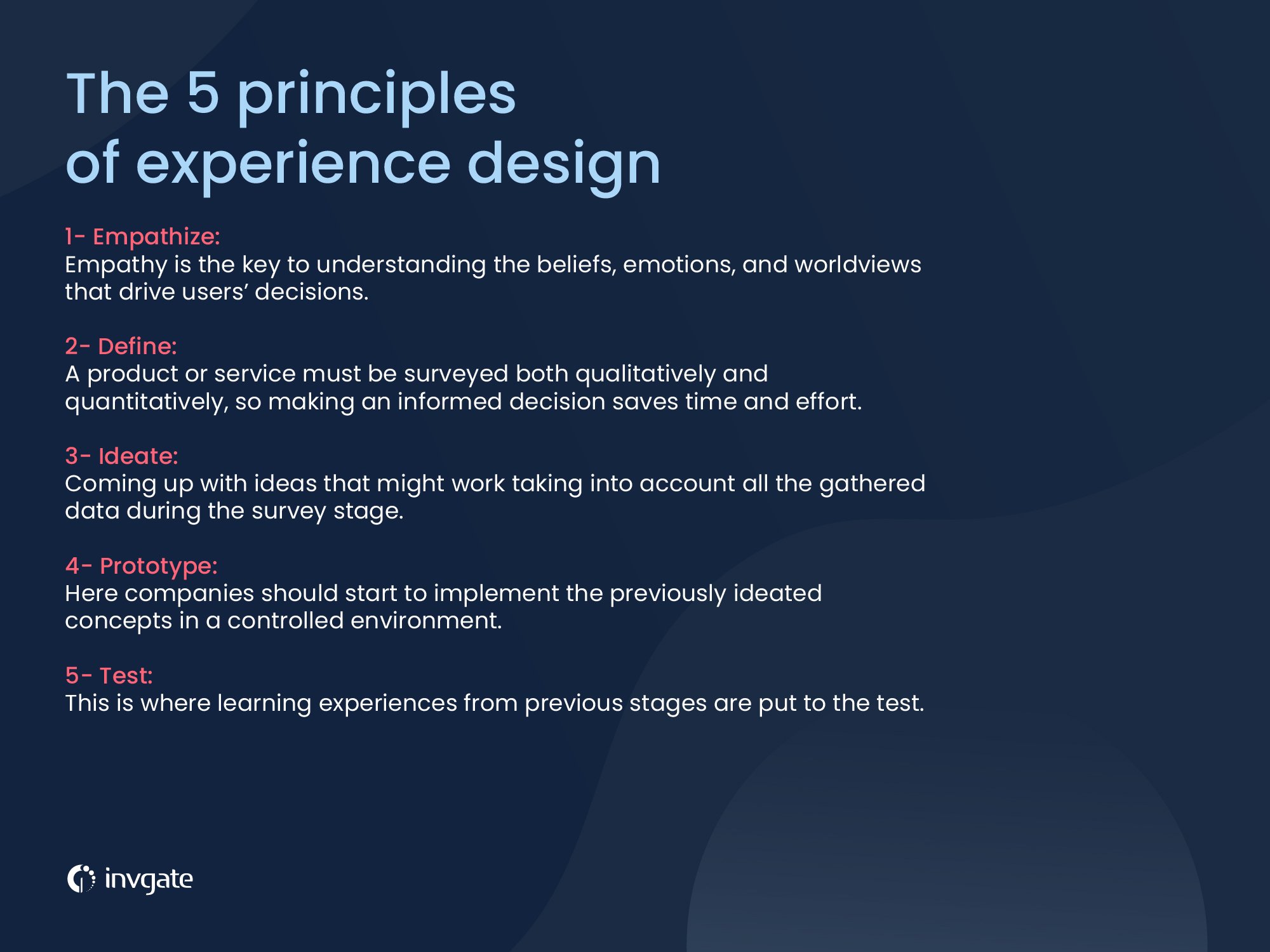
Experience design vs. design thinking
Experience design and design thinking have a lot in common. Mostly, they share that both seek to understand users using research, ideation, prototyping, and testing methods to deliver a better experience.
Because there is overlap, the differences are relatively subtle. Design thinking, on the one hand, tends to deal with everyday problems with design decisions, such as joint problems. It works better to assess design decisions or the stages of experience follow protocols that assure satisfactory outcomes. Think of design thinking as a headspace where the process is being carried out.
Experience design, on the other hand, is a more focused approach. While it does follow specific rules and stages, it is not as “meta” as design thinking. Experience design goes further into details that try to elicit feelings and emotions from customers. It’s, by design, entirely more of a creative solution geared towards specific products and services.
Of course, it bears repeating that experience design and design thinking are inextricably linked, and both are used in tandem to achieve a company’s goals.
Key takeaways
Experience design is here to stay.
Its primary goal is not just to provide a service but rather a service that customers return to. As a discipline, it urges companies to put themselves in the customer’s shoes and use empathy to get to the core of what makes consumers return to certain brands. In this sense, user experience is part of experience design — but not the single defining factor to its success.
The shift from a service economy to an experience economy is unavoidable. If there's something to remember about all we've just covered, this might be it: people tend to pinpoint how a situation made them feel way better than what happened.












